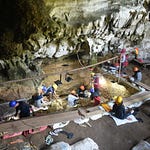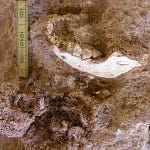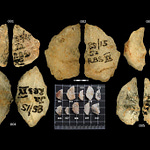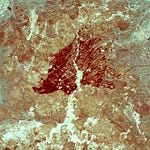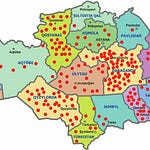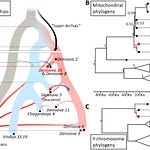A Genetic Speed Bump on the Road to Sahul
In the scrublands of northern Australia lies a rock shelter known as Madjedbebe. It has long stood as the oldest evidence of human occupation on the continent, with artifacts reportedly dating back at least 65,000 years. Stone tools, ochre crayons, and hearths buried deep within its sandy layers suggest that humans arrived in Sahul—the Ice Age supercontinent combining Australia, New Guinea, and Tasmania—well before most models predicted.

But a new study by archaeologists Jim Allen and James O’Connell, published in Archaeology in Oceania1, offers a different timeline. The earliest Australians, they argue, likely didn’t arrive until closer to 50,000 years ago. Their reasoning rests not on tools or stratigraphy, but on strands of ancient DNA.
Following the Genetic Breadcrumbs
Every person of non-African descent carries a small but consistent legacy of Neanderthal ancestry—about two percent of their genome. This includes Aboriginal Australians. Genomic data suggest that this Neanderthal inheritance came from a single interbreeding event between Homo sapiens and Neanderthals somewhere between 50,500 and 43,500 years ago, most likely in Eurasia.
"Such data offer no support for a purported 65 kya human presence on the continent," Allen and O’Connell write. If Australians carry Neanderthal DNA, then their ancestors must have interbred with Neanderthals before reaching Sahul—and that would make a pre-50,000-year migration unlikely.
Most Sahul archaeological sites, they point out, already fit this narrative. From Papua New Guinea's highlands to Western Australia's rock shelters, nearly all confirmed human sites date between 43,000 and 54,000 years ago. Only Madjedbebe stands out, with its disputed 65,000-year-old layers.
The Madjedbebe Problem
Madjedbebe's status as the archaeological cornerstone of early Sahul colonization has long been a source of pride and controversy. A 2017 study by Chris Clarkson and colleagues used optically stimulated luminescence (OSL) dating to place human presence at the site tens of millennia earlier than previously thought.
Skeptics note that sandy sediments like those at Madjedbebe are notoriously prone to post-depositional disturbance. Grains can drift. Layers can invert. Older sediments can settle around newer artifacts, making them appear older than they are.
"If the data is right," said O’Connell, "then the people responsible for Madjedbebe are not ancestral to any significant degree to modern Sahul populations."
This raises a strange possibility: perhaps there was an earlier wave of Homo sapiens in Australia that left no genetic trace, no cultural legacy, and vanished without a footprint beyond this single site.
Painting History in Sulawesi
Yet other data complicate this tidy genetic picture. On the island of Sulawesi, just north of Australia, researchers have dated rock art to at least 51,200 years ago. The art includes depictions of animals and humans, suggesting a rich symbolic culture.
Adam Brumm of Griffith University argues that the artists of Sulawesi and the early settlers of Sahul may have shared a common cultural ancestry:
"There is a very real possibility that the people who created the earliest artworks from Sulawesi were a part of the same broader cultural group that went on to colonize Sahul some 65,000 years ago."
Artifacts from other nearby sites, including a resin-coated tool from New Guinea dated to over 51,000 years ago, indicate early mastery of adhesives and organic materials. These finds hint at complex behavior well before the 50,000-year threshold proposed by genetic models.
The Myth of the Paleolithic “Revolution”
Allen and O’Connell lean on the idea of a behavioral turning point—sometimes dubbed the Paleolithic Revolution—around 50,000 years ago. They suggest that human groups at this time began developing symbolic expression, efficient tools, and long-distance migration strategies.
But critics argue that this so-called revolution may not have been as abrupt as it seems.
"In Africa, decades of research now clearly show the presence of complex behaviors tens of thousands of years earlier," write Huw Groucutt and Eleanor Scerri in a commentary. "Arguably occurring in a gradual and piecemeal fashion."
If such behaviors had emerged earlier and diffused gradually out of Africa, then the colonization of Sahul at 65,000 years ago might not be so unlikely after all.
DNA and Dirt: A Reconciliation
The genetic clock and the archaeological record are not necessarily at war. Instead, they offer different lenses into the past, each with strengths and blind spots. DNA reflects only the ancestors who left biological descendants. Archaeology records activity, even when the actors left no genes behind.
"Future Sahul discoveries may well include sites older than 50 kya," Allen and O’Connell concede, "but human arrival in Sahul at or before 65 kya currently lacks similar global-scale correlates."
The truth may lie somewhere in the sediments between Madjedbebe’s earliest artifacts and the mitochondrial molecules that crisscross our genomes. New discoveries—be they DNA from ancient remains or tools from yet-unexcavated shelters—may one day settle the score.
For now, the debate is not a conflict between archaeology and genetics. It is a conversation. One that asks: what does it mean to be first? And what kinds of evidence will we accept as answers?
Related Research
Clarkson, C., Jacobs, Z., Marwick, B., et al. (2017). Human occupation of northern Australia by 65,000 years ago. Nature, 547(7663), 306–310. https://doi.org/10.1038/nature22968
Nielsen, R., Akey, J. M., Jakobsson, M., et al. (2017). Tracing the peopling of the world through genomics. Nature, 541, 302–310. https://doi.org/10.1038/nature21347
Brumm, A., et al. (2021). Oldest cave art found in Sulawesi. Science Advances, 7(3), eabd4648. https://doi.org/10.1126/sciadv.abd4648
Groucutt, H. S., & Scerri, E. M. L. (2020). Cultural complexity and the idea of a Paleolithic revolution. Nature Ecology & Evolution, 4, 164–165. https://doi.org/10.1038/s41559-019-1071-3
Allen, J., & O’Connell, J. F. (2025). Recent DNA Studies Question a 65 kya Arrival of Humans in Sahul. Archaeology in Oceania. https://doi.org/10.1002/arco.70002


